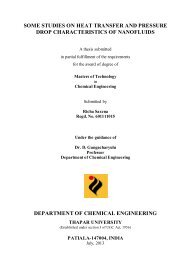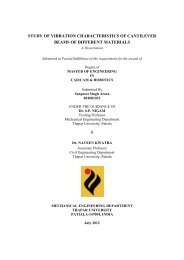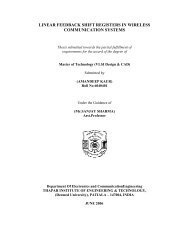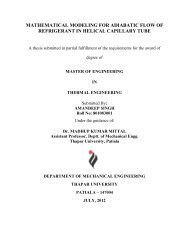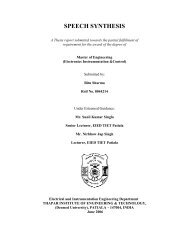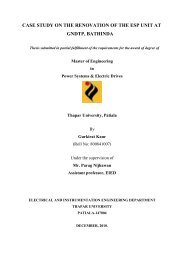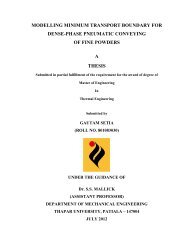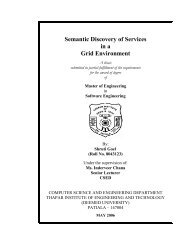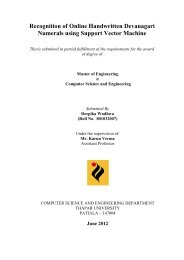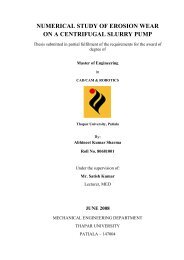- Page 1:
Characterization of Lactobacilli is
- Page 5 and 6:
their encouragement, insightful com
- Page 7 and 8: 5. Mukesh Kumar and Abhijit Ganguli
- Page 9 and 10: 2.3.2.9 Cholesterol lowering 2.3.2.
- Page 11 and 12: 3.12.4 Measurement of intracellular
- Page 13 and 14: List of Abbreviations ABTS 2,2-azin
- Page 15 and 16: LIST OF TABLES Tables Page No. Tabl
- Page 17 and 18: Chapter 1 INTRODUCTION
- Page 19 and 20: 2 Chapter I: Introduction Recent re
- Page 21 and 22: 4 Chapter I: Introduction Gram-posi
- Page 23 and 24: 6 Chapter I: Introduction food-born
- Page 25 and 26: 8 Chapter I: Introduction beneficia
- Page 27 and 28: Chapter I1 REVIEW OF LITERATURE
- Page 29 and 30: Chapter II Review of Literature nee
- Page 31 and 32: 13 Chapter II Review of Literature
- Page 33 and 34: 15 Chapter II Review of Literature
- Page 35 and 36: Chapter II Review of Literature ald
- Page 37 and 38: Chapter II Review of Literature man
- Page 39 and 40: 21 Chapter II Review of Literature
- Page 41 and 42: Chapter II Review of Literature gai
- Page 43 and 44: 25 Chapter II Review of Literature
- Page 45 and 46: Chapter II Review of Literature sur
- Page 47 and 48: 29 Chapter II Review of Literature
- Page 49 and 50: Chapter II Review of Literature col
- Page 51 and 52: Chapter II Review of Literature and
- Page 53 and 54: Fig. 2.1 Postulated mechanisms of a
- Page 55 and 56: Chapter II Review of Literature 200
- Page 57: Chapter II Review of Literature dia
- Page 61 and 62: 2.4.1 Mode of action 43 Chapter II
- Page 63 and 64: 45 Chapter II Review of Literature
- Page 65 and 66: 47 Chapter II Review of Literature
- Page 67 and 68: Chapter II1 MATERIALS & METHODS
- Page 69 and 70: 50 Chapter III Material and methods
- Page 71 and 72: 52 Chapter III Material and methods
- Page 73 and 74: 54 Chapter III Material and methods
- Page 75 and 76: 56 Chapter III Material and methods
- Page 77 and 78: 3.7 Characterization of probiotic p
- Page 79 and 80: 3.7.3.3 Bile salt hydrolase activit
- Page 81 and 82: 62 Chapter III Material and methods
- Page 83 and 84: 64 Chapter III Material and methods
- Page 85 and 86: 66 Chapter III Material and methods
- Page 87 and 88: 3.10.5 Purification of the bacterio
- Page 89 and 90: 70 Chapter III Material and methods
- Page 91 and 92: 72 Chapter III Material and methods
- Page 93 and 94: 4.1 Isolation of Lactobacilli IV. R
- Page 95 and 96: Chapter IV: Results Table 4.1: Morp
- Page 97 and 98: 77 Chapter IV: Results 4.3 Survival
- Page 99 and 100: 79 Chapter IV: Results Fig. 4.1 (C)
- Page 101 and 102: 4.6 Molecular characterization of t
- Page 103 and 104: 4.6.1 Sequence alignment of Lactoba
- Page 105 and 106: 85 Chapter IV: Results has probioti
- Page 107 and 108: 87 Chapter IV: Results Table 4.8 Al
- Page 109 and 110:
89 Chapter IV: Results Table 4.10 A
- Page 111 and 112:
91 Chapter IV: Results Table 4.12 A
- Page 113 and 114:
4.7.2 Survival of Lactobacillus str
- Page 115 and 116:
4.7.4 Antagonistic activity against
- Page 117 and 118:
97 Chapter IV: Results Table 4.17 H
- Page 119 and 120:
Table 4.19 Adhesion of potential pr
- Page 121 and 122:
Table 4.20 Coaggregation a of poten
- Page 123 and 124:
103 Chapter IV: Results Fig. 4.6 Ad
- Page 125 and 126:
105 Chapter IV: Results Table 4.21
- Page 127 and 128:
Table 4.23 Effect of pH and Tempara
- Page 129 and 130:
109 Chapter IV: Results Fig. 4.9 CL
- Page 131 and 132:
111 Chapter IV: Results 4.11.1 Effe
- Page 133 and 134:
113 Chapter IV: Results monocytogen
- Page 135 and 136:
115 Chapter IV: Results A B C D Fig
- Page 137 and 138:
4.13.3 Membrane permeability 117 Ch
- Page 139 and 140:
Chapter V DISCUSSION
- Page 141 and 142:
120 Chapter V Discussion al., 2003)
- Page 143 and 144:
122 Chapter V Discussion Lactobacil
- Page 145 and 146:
124 Chapter V Discussion or natural
- Page 147 and 148:
126 Chapter V Discussion trait may
- Page 149 and 150:
128 Chapter V Discussion and the el
- Page 151 and 152:
130 Chapter V Discussion hexadecane
- Page 153 and 154:
132 Chapter V Discussion hypothesiz
- Page 155 and 156:
134 Chapter V Discussion would prev
- Page 157 and 158:
136 Chapter V Discussion gave maxim
- Page 159 and 160:
138 Chapter V Discussion for 90 min
- Page 161 and 162:
140 Chapter V Discussion To test th
- Page 163 and 164:
CONCLUSIONS The main objective of t
- Page 165 and 166:
145 Chapter V: References Aasen, I.
- Page 167 and 168:
147 Chapter V: References Bjorksten
- Page 169 and 170:
149 Chapter V: References negative,
- Page 171 and 172:
151 Chapter V: References Delves-Br
- Page 173 and 174:
153 Chapter V: References Franz, C.
- Page 175 and 176:
155 Chapter V: References Gordon, D
- Page 177 and 178:
157 Chapter V: References Isolauri,
- Page 179 and 180:
159 Chapter V: References Kolenbran
- Page 181 and 182:
161 Chapter V: References Marekova,
- Page 183 and 184:
163 Chapter V: References Nagy, A.,
- Page 185 and 186:
165 Chapter V: References Bifidobac
- Page 187 and 188:
167 Chapter V: References Schilling
- Page 189 and 190:
169 Chapter V: References Teuber, M
- Page 191 and 192:
171 Chapter V: References Yoon, Y.C
- Page 193 and 194:
Rogosa agar Ingredients Quantity (g
- Page 195 and 196:
Denaturing solution. guanidinium is
- Page 197:
Appendix II Fig. 3.1. Standard curv



